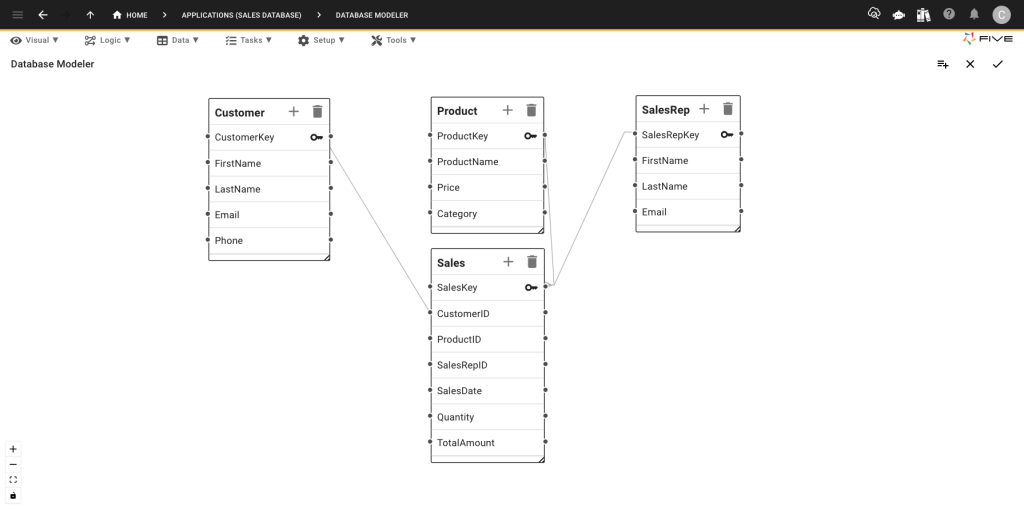Create a Sales Database In 3 Steps
How to Create a Sales Database
A sales database is important for businesses that want to effectively manage their customer relationships and track sales performance.
It serves as the central source of truth for managing sales amounts, dates, salesperson details, customer interactions, pipelines, and revenue forecasts.
If you don’t know where to begin, this guide will walk you through the process of creating an efficient sales database. It helps you avoid issues like missed opportunities, inaccurate forecasting, and poor customer relationship management.
Let’s dive in and learn how to develop a sales database.
Why Build a Sales Database?
A good sales database is key to smooth sales operations. It helps you:
- Keep track of sales amounts and targets
- Stay on top of customer interactions and relationships
- Monitor sales pipeline and progress
- Manage leads and opportunities
- Ensure timely follow-ups with prospects and clients
- Analyze sales performance and trends
Having all your sales information in one place means everyone in your sales team is on the same page. This allows you to make smarter decisions about sales strategies, resource allocation, and customer engagement.
What Is a Sales Database?
A sales database is a centralized system that stores detailed information about your sales activities, customers and transactions. This includes sales amounts, sales targets, customer names, contact details, purchase histories, sales pipeline stages, deal values, and any relevant notes or follow-up actions.
Depending on your industry, you might also track additional attributes like sales territories, product interests, competitor benchmarking data, contract terms, sales reps, sales quotas, and specific conditions or agreements (e.g., “preferred customer,” “long-term contract”).
Imagine you’re managing sales for a company. Your main CRM system might handle the basics, like who your customers are and what they’ve purchased. However, it might not be great at keeping track of all the details, such as ongoing negotiations, customer feedback, or sales performance metrics.
That’s where a well-structured sales database comes in handy. It serves as a one-stop resource for everything related to your sales activities. You can easily search and access information, helping you stay on top of your sales pipeline, track progress, and ensure that no opportunities slip through the cracks.
Why Spreadsheets Fall Short for Sales Databases
Many businesses start by tracking their sales activities in Excel or Google Sheets. It might seem convenient at first, especially when your sales team is small. However, as your business grows, relying on spreadsheets can lead to significant challenges:
Version Chaos
Before you know it, everyone in your sales team got their copy. You end up with a mess of files like “SalesNorthWest_LATEST,” “Sales Database – Updated,” “Old Sales Last Quarter – IGNORE,” and so on. Who knows which one’s right? This is not to mention that consolidating data in Excel is time-consuming, tedious and often leads to errors.
No Clear History
Without a proper system, it’s hard to keep track of who changed what and when. If the person in charge of updates leaves, you might be left scratching your head about why certain changes were made. Handing over from one sales rep to another can also be confusing: how do you know whether the list of opportunities is complete? An Excel can easily be tampered with.
Data Gets Messy
People start adding their own notes, highlighting things, and making manual tweaks. Soon enough, you’ve got a rainbow of colors and comments that don’t make sense to anyone else. For example, someone might mark a customer in red to show they’re unreliable with payments, but others might miss it or misunderstand.
Using spreadsheets for your sales data defeats the purpose of having a single, reliable source of information. Instead of efficiently managing your sales pipeline, you end up spending time reconciling conflicting data and trying to figure out what’s current.
Building a dedicated sales database with the right tools can solve these problems. It provides a central, reliable source of information that everyone on your sales team can trust and use effectively.
How to Create a Sales Database in 3 Steps
Running a business is demanding, and learning database management might not be at the top of your list. Typically, creating a sales database would require knowledge of SQL and user interface design—a daunting task when you’re busy with day-to-day operations or chasing your sales targets.
That’s why many businesses delay building a proper sales database. It seems complicated and time-consuming. But that’s where tools like Five come in. Five is an online database builder that simplifies the process of creating a sales database.
While it’s not as simple as snapping your fingers, it’s far easier than spending weeks learning to code from scratch.
With Five, you can:
✅ Quickly set up your sales database and get a user-friendly interface without any extra work.
✅ It’s easy to import your existing sales data from Excel or other spreadsheets, so you don’t have to start from scratch.
✅ You can also add custom features like detailed reports about your sales and set up charts to help you visualize your data at a glance. These visualizations let you easily compare sales data by territory, sales rep, or quarter.
✅ One of the handiest features is the ability to set up alerts that let you know when it’s time to notify clients about a new sales promotion.
✅ Plus, apps developed in Five work on any device. So whether you’re at your desk or on the go, you can always check your supplier info. This is great for outside sales reps who want to maintain or view data on their smartphones.
Want to give it a shot? Here’s how to get started:
1. Sign up for free.
2. Make your own supplier database (or use a template to get started)
3. Add forms to collect the info you need
4. Set up logins for your team, and even for suppliers if you want.
Five has a team of experts ready to assist you with your development and customizations. So, if you ever feel like you’re in need of a new dashboard or a form field, don’t worry, our expert developers are here to help. And yes, we promise not to charge you an arm and a leg or leave you with a system that only we understand!
Step 1: What You Need to Know About Your Sales
First things first, think about what information you really need about your sales. What matters most to your business? What do your team and customers care about? Which metrics would you like to track?
You want your sales database to be the go-to place for all this information, so make it as comprehensive as possible.
Here’s a list of things you might want to keep track of:
- Customer ID and Name
- Products or services they’ve purchased
- Prices and discounts applied
- Purchase history and frequency
- Customer contact details
- Sales pipeline stage
- Lead sources
- Contract terms and renewal dates
- Sales performance metrics
- Sales reps
- Payment history and terms
- Feedback and satisfaction ratings
Step 2: Think About How You Manage Your Sales
Your sales database isn’t just a list or a spreadsheet. It’s a tool that should help you manage your sales process day-to-day. Consider tracking:
✅ When deals are made:
Record dates of sales, what was sold, and when delivery or service is scheduled.
✅ Sales performance:
Track metrics like conversion rates, deal sizes, and how well sales reps are performing.
✅ How much gets sold of what and when:
Knowing what sells is important for any organization. Keep track of sales amounts, dates, and transactions.
✅ Customer interactions:
Keep notes on when you contacted customers, what was discussed, and any follow-up actions needed.
✅ Payment tracking:
Monitor when invoices are sent, when payments are received, and any payment issues.
The more detailed your records, the more valuable your sales database will become. For example, if you want to analyze which customers are the most valuable or which products sell best, you’ll need to have been recording that data all along.
Remember, a good sales database evolves with your business. Start with the essentials, and you can always add more detail as you grow.
Step 3: Creating Your Sales Database
With your list of sales attributes and additional information ready, it’s time to move all of this into a proper database.
To do so, sign up for Five, an online database builder that comes with a simple point-and-click interface for creating relational databases.
Follow our video tutorial to build your database tables, forms, and reports, and start managing your sales efficiently.
The Sales Database Schema
Here’s the database schema for our application:
Customer Table
At the core of the database, this table stores detailed information about customers and their attributes, including contact information and purchase history.
Product Table
This table contains information about the products or services offered, including pricing, descriptions, and categories.
Sales Table
A critical component of the schema, this table tracks individual sales transactions, linking customers to the products they’ve purchased. It includes details such as sale dates, quantities, and payment status.
Sales Rep Table
This table stores information about your sales team, linking them to the sales they’ve made and providing a clear view of performance metrics.
Each table holds specific information, such as customer details, sales history, product information, and sales rep assignments, ensuring a comprehensive and organized structure for managing your sales data efficiently.

Sales Database: Key Features
A Customizable Sales Database
Using Five’s Table Wizard, we can turn the table and field definitions of our database into working software. Five gives you a user-friendly, point-and-click database design tool that non-technical users can use to rapidly create a custom database. Add as many fields as you wish to your sales database.
The database is fully customizable and runs on MySQL, one of the world’s most popular open-source database technologies.
Simple-to-Use Forms
Next, Five lets us add forms so that we can enter data into our database. Forms enable us to store or retrieve information from our database. In addition, we can create charts, dashboards, or even PDF reports, which are ideal for tracking sales.
Login Protected and Secure
Securing sales data is paramount for organizations of all sizes. Five comes with a pre-built authentication feature that adds a login screen to your application. For example, every (registered) sales rep can have their own login to the application to view or edit data. You can also add multi-factor authentication for extra security.
Generate Documents
Five lets you generate documents straight from inside the application. For example, you can easily create monthly reports about sales rep performance, and build approval workflows for different deal stages.
Searchable and Online
The sales database is searchable and hosted online. It can be accessed by any device and at any time.
Get Started with Five Today
To build your sales database with Five, sign up for free access and start the process. If you need assistance, visit our forum for help from our application development experts.
By following the steps mentioned above, you can create robust and scalable sales software tailored to your needs.


